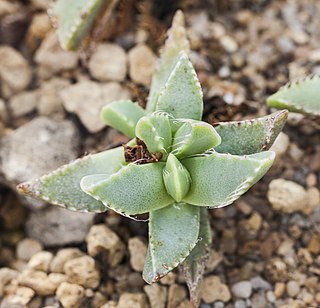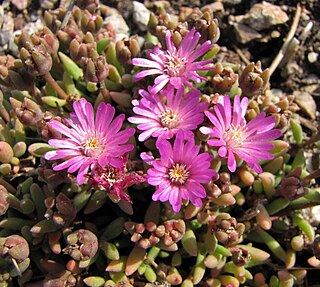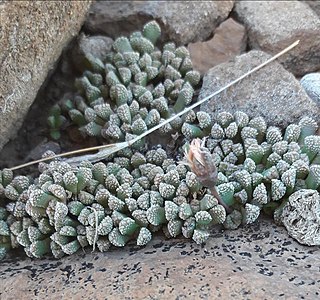
Sparaxis is a genus of flowering plants called the harlequin flowers. It belongs to the iris family Iridaceae with about 13 species endemic to Cape Province, South Africa.

The Aizoaceae, or fig-marigold family, is a large family of dicotyledonous flowering plants containing 135 genera and about 1800 species. They are commonly known as ice plants or carpet weeds. They are often called vygies in South Africa and New Zealand. Highly succulent species that resemble stones are sometimes called mesembs.

Ceanothus is a genus of about 50–60 species of nitrogen-fixing shrubs and small trees in the buckthorn family (Rhamnaceae). Common names for members of this genus are buckbrush, California lilac, soap bush, or just ceanothus. "Ceanothus" comes from Ancient Greek: κεάνωθος (keanōthos), which was applied by Theophrastus to an Old World plant believed to be Cirsium arvense.

Daboecia, or St. Dabeoc's heath, is a small genus of flowering plants in the family Ericaceae, containing two evergreen shrubs, closely related to the genus Erica. They are native to cliffs and heathland in southern Atlantic Europe and the Azores.

Molinia caerulea, known by the common name purple moor-grass, is a species of grass that is native to Europe, west Asia, and north Africa. It grows in locations from the lowlands up to 2,300 m (7,546 ft) in the Alps. Like most grasses, it grows best in acid soils, ideally pH values of between 3.5 and 5, however, it can continue to live under more extreme conditions, sometimes to as low as 2. It is common on moist heathland, bogs and moorland throughout Britain and Ireland. Introduced populations exist in northeastern and northwestern North America.

Armeria maritima, the thrift, sea thrift or sea pink, is a species of flowering plant in the family Plumbaginaceae. It is a compact evergreen perennial which grows in low clumps and sends up long stems that support globes of bright pink flowers. In some cases purple, white or red flowers also occur. It is a popular garden flower and has been distributed worldwide as a garden and cut flower. It does well in gardens designed as xeriscapes or rock gardens. The Latin specific epithet maritima means pertaining to the sea or coastal.

Pleiospilos is a genus of succulent flowering plants of the family Aizoaceae, native to South Africa. The name is derived from the Greek pleios "many" and spìlos "spot". The plants are also known as kwaggavy, lewerplant, lewervygie, klipplant, split rock or mimicry plant.

Agapanthus inapertus, the Drakensberg agapanthus, drooping agapanthus, or closed African lily, is a species of flowering plant in the family Amaryllidaceae, native to open grasslands, forest margins and mountainous, rocky areas of Mozambique, Eswatini (Swaziland), and South Africa.

Conophytum jucundum is a species of succulent plants belonging to the family Aizoaceae. As its synonym Conophytum gratum, the pleasing cone plant, it has gained the Royal Horticultural Society's Award of Garden Merit.

Pleiospilos bolusii, the mimicry plant, is a species of flowering plant in the family Aizoaceae, native to the Eastern Cape of South Africa, where it grows at an altitude of 750–1,100 m (2,461–3,609 ft). The species epithet bolusii honours Harry Bolus, a 19th-century South African botanist.

Faucaria felina, tiger jaws, is a species of succulent plant in the family Aizoaceae. It is endemic to the southern Cape Provinces of South Africa, but also widely spread in culture. It has a clumping habit and blooms with yellow flowers. As its synonym Faucaria candida, white tiger jaws, it has gained the Royal Horticultural Society's Award of Garden Merit.

Genista sagittalis, called the arrow-jointed broom and winged broom, is a species of flowering plant in the genus Genista, native to central and southern Europe, Ukraine, and Anatolia. Its subspecies Genista sagittalis subsp. delphinensis, called rock broom, has gained the Royal Horticultural Society's Award of Garden Merit.

Delosperma aberdeenense, called the Aberdeen dew plant, is a species of flowering plant in the ice plant family Aizoaceae, native to the Cape Provinces of South Africa. It has gained the Royal Horticultural Society's Award of Garden Merit.
Tanquana is a genus of flowering plants belonging to the family Aizoaceae.

Neohenricia sibbettii, called the coral plant, is a species of flowering plant in the genus Neohenricia, native to South Africa. A succulent, it has gained the Royal Horticultural Society's Award of Garden Merit.
Erepsia is a genus of flowering plants belonging to the family Aizoaceae.

Androsace laggeri, the pink rock jasmine, is a species of flowering plant in the family Primulaceae, native to the central Pyrenees. As Androsace carnea subsp. laggeri it has gained the Royal Horticultural Society's Award of Garden Merit.

Disocactus speciosus, the sun cactus, is a species of flowering plant in the family Cactaceae. It is native to Mexico, Honduras and Guatemala, and has been introduced to the Canary Islands. As its synonym Heliocereus speciosus it has gained the Royal Horticultural Society's Award of Garden Merit.

Genista hispanica, the Spanish gorse, or anlaga, is a species of flowering plant in the family Fabaceae, native to southern France and northern Spain. It is suited for borders, wall and rock gardens, gravelly soils, and coastal situations.

















